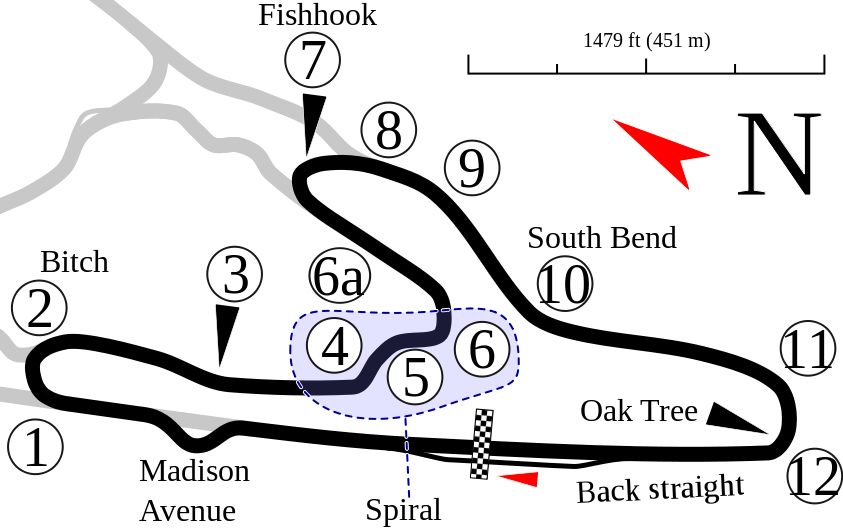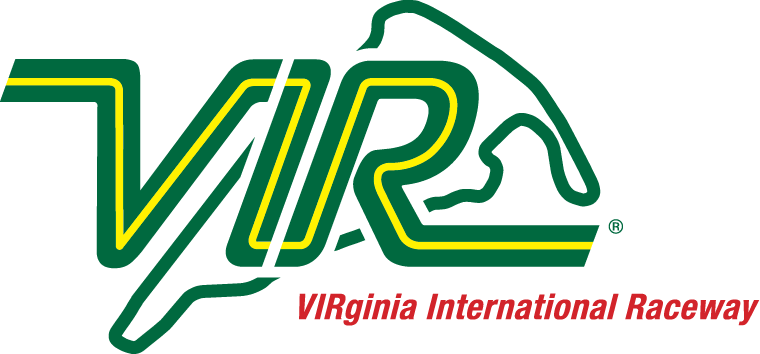
Virginia International Raceway (commonly known as "VIR") is a race track located in Alton, Virginia, near Danville. VIR offers six track configurations, of which two can be run simultaneously. The "Full Course" is 3.27 miles in length while the "Patriot Course" stretches for 1.1 miles entirely inside the Full Course. The "North Course" is 2.25 miles long and the "South Course" covers a distance of 1.65 miles. Both consist of a portion of the "Full Course" and short connecting sections that connect to portions of the "Patriot Course" to produce the two courses that can run simultaneously. There is a second pit complex that is used only when running the "South Course". The longest configuration, "Grand East Course", is 4.2 miles long, and combines most of the "Full Course" and most of the "Patriot Course" by means of two of the short sections of connecting track used to make the "South Course" and "North Course". There is also another, seldom run, long configuration called the "Grand West Course" that uses the other two short connecting sections between the "Full Course" and the "Patriot Course." - Learn more on: Wikipedia
NOTE: This is a dynamic page, if this page is not displaying any data, please use the TRACK GUIDE menu to reselect this venue!
| Travel Guide | Turn-by-Turn |
Paddock (South)
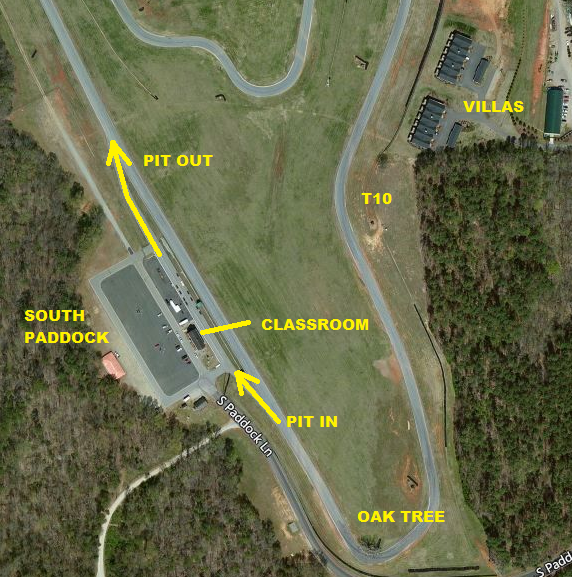
Passing Zones
Note: All passing zone data depicted below is based on "advanced driver" rules, if you are in a different run group please consult your organization or chief instructor for passing zones that are appropriate for your run group.
No Passing Zone information is currently available.Turn-by-Turn
- Turn 10: A very fast, downhill left hander. The keys to executing turn 10 well are car positioning on entry and vision. It is important to turn in from extreme track right to maximize effective curve radius and, thus, speed; this requires preparing for turn 10 entry while still in and exiting turn 9.Turn 10 used to be somewhat deceptive with an apex that appeared later than it was. Part of the issue I believe was limited surface grip which induced understeer in most cars. After the repave there is no shortage of grip in turn 10, but vision techniques are still useful for taking turn 10 at maximum speed.When approaching the turn, you should be looking for the apex on the left. You want to see the apex as soon as it physically appears in your line of sight, which should happen around the turn in point. Focus on the apex as you are adding steering input. When you are certain you are going to hit the apex, look for the track out point. For less experienced or less aggressive drivers, the track out point would be the curb at corner exit. For more experienced and more aggressive drivers it would be the edge of the pavement a few feet past the end of the curb. Use the entire track width for optimum lap time.
- Turn 11: The first turn of the oak tree combination, some people treat turn 11 as a throwaway corner but substantial time can still be given up in it. Turun 11 is an entry speed corner - the goal is to preserve the speed on the short straight between turns 10 and 11 for as long as possible, and thus to brake as late as possible. The line and attitude of the car between turns 11 and 12 determines precise braking point for each car.Turn 11-12 sequence is similar to the turn 2-3 sequence in that some braking is needed and the car is never really traveling in a straight line. As such, the way a driver would take the 2-3 sequence is often similar to how they would take the 11-12 sequence: cars with stronger understeer tendencies can brake later, harder and while turning more, while neutral cars and cars prone to oversteer might prefer to brake earlier, gentler and in more of a straight line.The very short straight between turns 11 and 12 is nonetheless long enough for some cars to apply throttle; I imagine most if not all of such cars would be faster overall had they braked later in turn 11 and took turn 11 quicker instead.The most crucial part of turn 11, of course, is completely tracking out and settling the car for turn 12.
- Turn 12: The oak tree turn is the most important turn on the track for lap time, being followed by the enormously long back straight. It is also a tricky turn to master.There are three principal approaches to turn 12: a smooth arc through turns 11 and 12, running a short straight between turns 11 and 12 and straightening turn 11.The smooth arc through turn 11 looks like this:
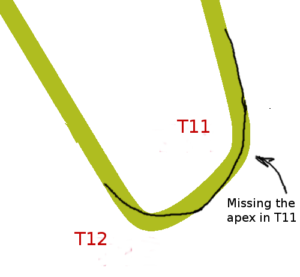 Most cars end up missing the apex in turn 11 so that they are on the left side of the pavement, parallel to the track, as they are approaching the turn in point for turn 12. This approach is generally the smoothest of the three - the car is decelerating through turn 11 with perhaps some maintenance throttle between 11 and 12.An alternative to the smooth arc is to segment turn 11 into two somewhat straight lines, like so:
Most cars end up missing the apex in turn 11 so that they are on the left side of the pavement, parallel to the track, as they are approaching the turn in point for turn 12. This approach is generally the smoothest of the three - the car is decelerating through turn 11 with perhaps some maintenance throttle between 11 and 12.An alternative to the smooth arc is to segment turn 11 into two somewhat straight lines, like so:
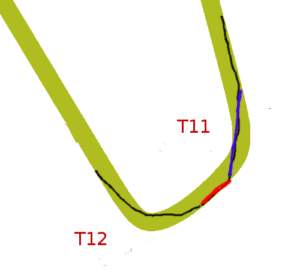 The blue line is taken under light braking, and most drivers apply a bit of throttle early on the red line followed by braking again for turn 12.A different derivative of the smooth arc line is a line that eliminates the straight between turns 11 and 12 entirely:
The blue line is taken under light braking, and most drivers apply a bit of throttle early on the red line followed by braking again for turn 12.A different derivative of the smooth arc line is a line that eliminates the straight between turns 11 and 12 entirely:
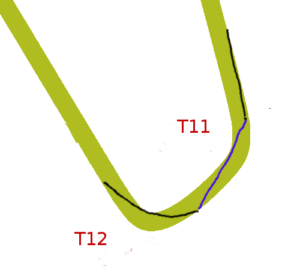
The idea here is to carry speed longer into turn 11, turn later, and brake through the entire blue line until the turn in point for turn 12.
Not all cars can run all three possible lines. Generally speaking, cars on stiffer suspension and with stickier tires have higher likelihood of being able to run the straight line approaches to turn 12. Cars on softer suspensions that roll more are often restricted to the smooth arc line or its close variations.
Drivers wishing to practice turn 12 line would be well served by running the South configuration of VIR which is much shorter in lap time than the Full configuration.
Turn-by-Turn Information provided by

©2018 - Oleg Pudeyev / Race & Track Driving ; with Permission.

